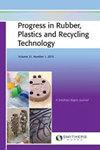Utilizing decommissioned windmill blades as reinforcement or filler for biocomposites
IF 1.6
4区 材料科学
Q4 MATERIALS SCIENCE, COMPOSITES
Progress in Rubber Plastics and Recycling Technology
Pub Date : 2024-05-09
DOI:10.1177/14777606241252705
引用次数: 0
Abstract
Decommissioned or damaged windmill blades and other wastes have limited applications and are generally disposed into landfills or incinerated. Increasing generation of wind energy will also lead to increase in blades available for disposal. It is estimated that more than 800,000 tons of blades will be available annually for disposal from 2050. Blades contain glass, carbon, resins and other valuable materials and hence it is prudent to develop methods to reuse or recycle the blades. In this study, we have used windmill blade waste (WBW) as reinforcement for polypropylene (PP) and also as filler/additive for coir-WBW-PP hybrid composites. Various proportions of the components were made into composites and studied for the changes in mechanical, acoustic, thermal and noise insulation properties. Tensile strength did not show major increase in properties whereas 70/30 WBW/PP composites had highest flexural strength and modulus. Addition of WBW considerably increased both the tensile and flexural properties of the hybrid composites with up to 180% increase in flexural strength and 173% increase in modulus. Similarly, hybrid composites had better thermal conductivity and the composites containing 80% WBW and 20% PP had the highest thermal conductivity. Coir improved the acoustic sorption due to the presence of pores and voids in the composites whereas WBW acts as filler and decreased the sound sorption. WBW can be effectively used as reinforcement or filler for PP based composites.利用退役风车叶片作为生物复合材料的增强剂或填料
退役或损坏的风车叶片和其他废物的用途有限,通常被丢弃到垃圾填埋场或焚烧。风能发电量的增加也将导致可供处置的叶片增加。据估计,从 2050 年起,每年将有超过 80 万吨的叶片可供处置。叶片中含有玻璃、碳、树脂和其他有价值的材料,因此开发叶片再利用或回收方法是非常谨慎的。在这项研究中,我们使用风车叶片废料(WBW)作为聚丙烯(PP)的增强材料,同时也作为椰壳纤维-WBW-PP 混合复合材料的填料/添加剂。将不同比例的成分制成复合材料,并研究其在机械、声学、热学和隔音性能方面的变化。拉伸强度并没有明显提高,而 70/30 WBW/PP 复合材料的弯曲强度和模量最高。添加 WBW 可显著提高混合复合材料的拉伸和弯曲性能,弯曲强度提高了 180%,模量提高了 173%。同样,混合复合材料具有更好的导热性,其中含有 80% WBW 和 20% PP 的复合材料具有最高的导热性。由于复合材料中存在孔隙和空隙,椰壳纤维提高了吸声性能,而 WBW 作为填充物则降低了吸声性能。WBW 可以有效地用作基于 PP 的复合材料的增强剂或填料。
本文章由计算机程序翻译,如有差异,请以英文原文为准。
求助全文
约1分钟内获得全文
求助全文
来源期刊

Progress in Rubber Plastics and Recycling Technology
MATERIALS SCIENCE, COMPOSITES-POLYMER SCIENCE
CiteScore
4.40
自引率
7.70%
发文量
18
审稿时长
>12 weeks
期刊介绍:
The journal aims to bridge the gap between research and development and the practical and commercial applications of polymers in a wide range of uses. Current developments and likely future trends are reviewed across key areas of the polymer industry, together with existing and potential opportunities for the innovative use of plastic and rubber products.
 求助内容:
求助内容: 应助结果提醒方式:
应助结果提醒方式:


